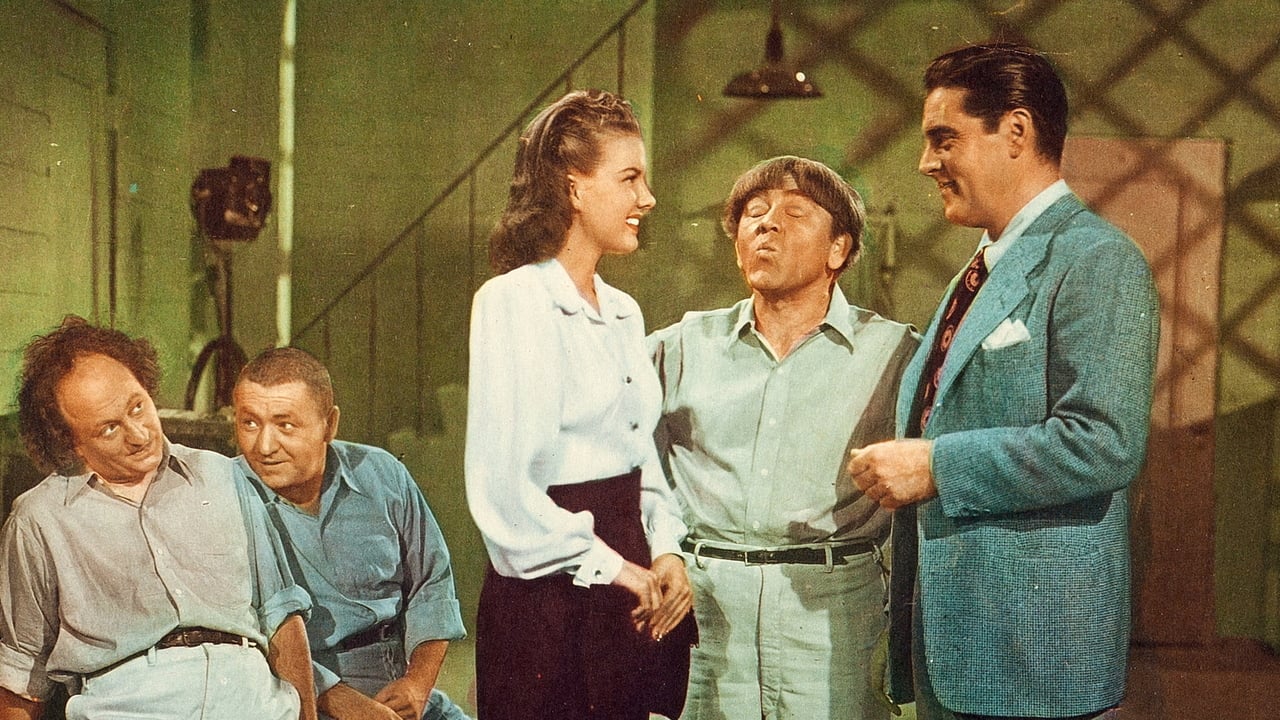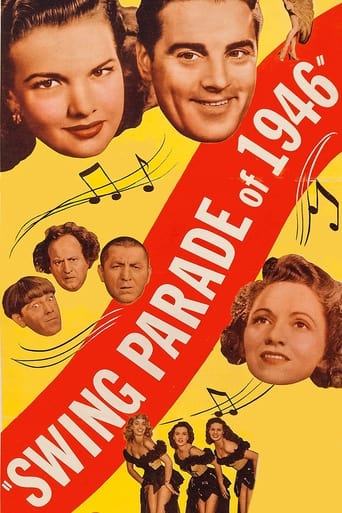

How sad is this?
... View MoreIt's hard to see any effort in the film. There's no comedy to speak of, no real drama and, worst of all.
... View MoreThe best films of this genre always show a path and provide a takeaway for being a better person.
... View MoreAfter playing with our expectations, this turns out to be a very different sort of film.
... View MoreAnd a few other co-stars, obviously. I'm not that well versed in "Poverty Row" entertainment, like some of the major studios. When it comes to Monogram or PRC, or a few of those other outfits, it's either hit or miss. The presence of the "Stooges" may be the obvious draw for this one--they definitely provide most of the humor; although Ed Brophy in a Healy type role is great himself. A lot of attractive women running around too--if you're into that sort of thing.The story--what there is of it--is easy enough to understand. Process servers, a father who doesn't want his son in the entertainment business, some jilted landlords, and a pretty good looking movie in spite of it's budget limitations. Usually these B or C grade turkeys look just like that--but, if you didn't no any better--this would look like the same sort of movie Columbia or Universal could have cranked out.
... View MoreBack when they first came to Hollywood, the Three Stooges were known as Ted Healy's Three Stooges and were his second bananas in his films. The boys tired of that and went from MGM to Columbia where the rest is history. Yet in Swing Parade Of 1946 they are functioning as Edward Brophy's stooges in the same manner they did for Healy.The guys are dishwashers who later become waiters when there is a shortage and Brophy is in charge of the food. They work in a restaurant nightclub that's owned by Phil Regan who's a rich kid and whose father Russell Hicks wants him not involved in show business. In fact he's trying to shut his son down by hook or crook. Gale Storm is an aspiring singer looking for a break.This rather threadbare plot is the hook to hang some musical numbers by Connee Boswell and orchestra leaders Will Bradley and Will Jordan and of course Regan and Storm. Not to mention the usual Stooge antics with the slow burning Brophy.Harry Cohn over at Columbia where the 3 Stooges normally worked and worked on time and under budget must have owed something to Sam Katzman at Monogram. Maybe he lost their services in a poker game. I can't figure out why they were working at Monogram for a single film.Swing Parade Of 1946 is pleasant enough, nothing outstanding about it.
... View MoreSwing Parade plays almost like one of those early talkie musical revues, that is, it has an acorn of a plot concerning an ambitious singer (Gale Storm) trying for a job in a nightclub. There are many musical numbers in the film's relatively short 74 minute running time, and just about everybody except The Three Stooges (quite funny here) gets a chance to sing. Gale Storm, one of my favorites, really gets a chance to show off her singing (and dancing) abilities here. Connee Boswell does a swell job on "Stormy Weather" and Louis Jordan tears up the stage doing "Caledonia". There is a big finale which looks like it cost little Monogram more of a chunk of money than they usually had to pay which again hearkens back to those early talkie revues. The version of the film I got can be viewed in it's original black-and-white or in a colorized version. A good example of an upscale Monogram film.
... View More"Swing Parade of 1946" is a film that is probably known only to Three Stooges aficionados, and indeed, the boys are given ample time to do their stuff, even though they are not the most prominent stars in the picture and Curly's failing health at the time put a damper on the famous slapstick trio. This rather obscure film focuses on the excitement of nightclub entertainment, with some great big band swing music for accompaniment, even if a majority of the big bands were drying up by 1946. Two of the featured songs are, in fact, well-known jazz standards ("Stormy Weather" and "On the Sunny Side of the Street"), but all the other songs are completely forgettable and cause the film to drag somewhat. In fact, the singing of "A Tender Word Will Mend It All" by bandleader Will Osborne and Marie Finch (Mary Treen) is probably the only bad & embarrassing moment in the film.Highlights: The colorful personality and dazzling presence of saxophonist/singer/dancer Louis Jordan absolutely steals the show, as he & his Tympany Five perform the fantastic jump tunes "Don't Worry About the Mule" and "Caldonia." The best musical moment for the somewhat shy, naive, overreacting Carol Lawrence (Gail Storm) is her fine rendition of "On the Sunny Side of the Street" as she auditions for nightclub owner Danny Warren (Phil Regan) while the Stooges listen approvingly (and in real life, Curly and Larry were especially fans of jazz). The young Windy Cook is very entertaining with his wild impressions of cars, trains, motorboats, airplanes, ginger ale bottles, and saws. While searching for a watch that slipped down a drain, the Stooges flood the basement of the nightclub, with Curly performing a variation of the maze-of-pipes routine that he started in the Columbia Stooge short "A Plumbing We Will Go" (1940). As waiters, the Stooges give a few customers a hard time; Moe insists to one customer that he have roast beef instead of roast turkey, and Curly sits down with an annoyed couple who haven't had their order taken for over thirty minutes. The boys also humorously eject an elderly gentleman (Russell Hicks), whom they think is a process server, from the club, not knowing that he is the father of Danny Warren! "Swing Parade of 1946" is indeed a special treat, with the two best acts being the Three Stooges and Louis Jordan & His Tympany Five. Also, watch for Edward S. Brophy as the well-meaning, yet hot-tempered, headwaiter Moose; Brophy worked with the Stooges (and their mentor Ted Healy) twice before in the 1933 MGM shorts "Beer and Pretzels" and "Hello Pop!"
... View More